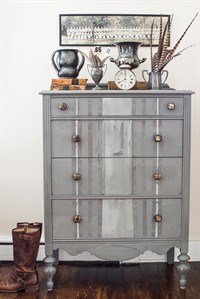
A dresser is pictured after its a face-lift in an undated photo. THE CANADIAN PRESS/HO, Miss Mustard Seed
September 17, 2014 - 2:00 AM
TORONTO - As a newlywed with little extra cash to spare, Marian Parsons adopted a cost-conscious approach to home furnishing.
She combed through yard sales and thrift stores and discovered a solid antique wood dresser requiring refinishing.
"I just thought: 'Well, if I mess it up, it was only $10,'" she recalled. "So I went ahead and refinished that piece and that sort of started it all."
Parsons sanded off the dark wood finish, topped it with polyurethane and placed ceramic knobs on the dresser, which would undergo several more makeovers before she finally sold it. A hobby born out of necessity about 15 years ago blossomed into a burgeoning business for the Pennsylvania-based entrepreneur and writer behind the popular interior design blog Miss Mustard Seed.
Parsons will be sharing her expertise at Toronto's Fall Home Show, which runs Thursday through Sunday at the Better Living Centre at Exhibition Place. Ahead of her first Canadian appearance, she offers tips on how to give preloved furniture a facelift.
1. Don't splurge — and start small.
"I think if you're just starting out, I would always suggest to people to start with a piece that's cheap or free," said Parsons. "That gives you a chance to experiment, to learn, because your first piece isn't always going to turn out great."
Rather than opting for a sizable piece, Parsons suggested starting small with a stool, ottoman or a dining chair — "something that you can finish in a day and celebrate that victory before you move on to something else."
2. Ensure the structure is sound.
"Just because something is cheap, don't be tempted to buy it just because it's cheap," said Parsons. "There are some pieces that are going to be beyond your ability to repair.
"Maybe there's a broken leg, or the drawers don't function at all ... or the back is falling off or it's really rickety and it needs to be taken apart and reglued. So unless you know someone who can do it or you happen to know how to do it, don't buy a piece that's going to be too difficult for you to fix."
There are instances where a little low-tech tinkering may do the trick. For example, if dresser drawers don't slide in and out with ease, Parsons said rubbing wooden runners with candle wax can help reduce friction.
3. Embrace surface flaws.
While ensuring the piece is sturdy is essential, Parsons said surface flaws that can be altered should be seen as a selling point.
"If the finish is a wreck or the paint colour is awful or the knobs are tacky, those are the things that you want to look for because those are things that a lot of people will overlook," she said.
A piece with worn upholstery that is free of stains or foul odours can be a great candidate for a fresh slipcover and reupholstery, she added.
4. Add a splash with the right tools.
Parsons said the appropriate choices of sandpaper, brushes and paint are key in helping personalize a preloved piece.
She recommends opting for three different grits of sandpaper: rough or coarse, medium and fine.
"When it's really rough, that's going to really scratch up the surface. That's good when you want to remove a finish, remove a paint, really smooth something out."
A fine grit paper is what gets the wood "buttery smooth."
"That's ultimately what you want when you're refinishing a piece. You want it to feel nice. You don't want to feel any splinters or the grain sticking up."
If the piece's original finish has a shine, Parsons said she "almost always" suggests sanding first.
"That doesn't mean stripping off that finish. It just means very lightly rubbing a piece of sandpaper over the entire piece," she said. "What that does is it creates small scratches in the finish that gives the paint something to cling to. It really helps with adhesion and when you prep the surface, you get a better end result."
A high-quality paintbrush is essential for application to furniture. Parsons said she likes using a five-centimetre (two-inch) angled brush. "What that allows you to do is to really get into the corners because the brush is angled, and it also allows you to create straight lines."
On her website, Parsons offers a breakdown of the pros and cons of various types of paint. As for her personal projects, when she isn't using her own line of Milk Paint, she likes acrylic for decorative purposes.
"What's nice about an acrylic paint is you don't have to use a primer or anything — you can just paint it. And if it's a satin finish it doesn't need any kind of a top coat to protect it. That paint will do fine all on its own."
5. Don't make every piece look alike.
Once you've honed your refinishing, reupholstering and refurbishing skills, you may use the same tools and approach in future, but Parsons recommends giving each piece a distinct look.
"I would suggest painting them in different finishes, mixing wood, mixing paint finishes, different fabrics. That way it stays interesting and it looks like the room was collected over time."
Follow @lauren_larose on Twitter.
———
Online:
www.fallhomeshow.com
www.missmustardseed.com
News from © The Canadian Press, 2014